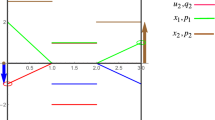Abstract
This article studies a numerical solution method for a special class of continuous time linear programming problems denoted by (SP). We will present an efficient method for finding numerical solutions of (SP). The presented method is a discrete approximation algorithm, however, the main work of computing a numerical solution in our method is only to solve finite linear programming problems by using recurrence relations. By our constructive manner, we provide a computational procedure which would yield an error bound introduced by the numerical approximation. We also demonstrate that the searched approximate solutions weakly converge to an optimal solution. Some numerical examples are given to illustrate the provided procedure.
Similar content being viewed by others
References
Anderson, E.J.: A continuous model for job-shop scheduling. Ph.D. thesis, Uniersity of Cambridge, Cambridge (1978)
Anderson E.J.: A new continuous model for job-shop scheduling. Int. J. Sys. Sci. 12, 1469–1475 (1981)
Anderson E.J., Nash P.: Linear Programming in Infinite Dimensional Spaces. Wiley, Chichester (1987)
Anderson E.J., Pullan M.C.: Purification for separated continuous linear programs. Math. Methods Oper. Res. 43, 9–33 (1996)
Anstreicher K.M.: Generation of feasible descent directions in continuous-time linear programming. Technical report SOL 83-18. Department of Operations Research, Stanford University, Stanford (1983)
Bellman R.: Dynamic Programming. Princeton University Press, Princeton (1957)
Buie R.N., Abrham J.: Numerical solutions to continuous linear programming problems. Z. Oper. Res. 17, 107–117 (1973)
Dantzig G.B.: Large scale systems optimization with applications to energy. Technical report SOL 77-3. Department of Operations Research, Stanford University, Stanford (1977)
Drews W.P.: A simplex-like algorithm for continuous-time linear optimal control problems. In: Cottle, R.W., Krarup, J. (eds) Optimization Methods for Resource Allocation, pp. 309–322. Crane Russak, New York (1974)
Fleischer L., Sethuraman J.: Efficient algorithm for separated continuous linear programs: the multi-commodity flow problem with holding costs and extensions. Math. Oper. Res. 30, 916–938 (2005)
Friedman A.: Foundations of Modern Analysis. Dover, New York (1982)
Grinold R.C.: Continuous programming part one: linear objectives. J. Math. Anal. Appl. 28, 32–51 (1969)
Grinold R.C.: Symmetry duality for a class of continuous linear programming problems. SIAM J. Appl. Math. 18, 84–97 (1970)
Hartberger R.J.: Representation extended to continuous time. In: Cottle, R.W., Krarup, J. (eds) Optimization Methods for Resource Allocation, pp. 297–307. Crane Russak, New York (1974)
Jóhannesson B., Hanson M.A.: On the form of solutions to the linear continuous time programming problem and a conjecture by Tyndall. J. Math. Anal. Appl. 111, 236–242 (1985)
Lehman R.S.: On the Continuous Simplex Method, RM-1386. Rand Corporation, Santa Monica, CA (1954)
Levinson N.: A class of continuous linear programming problems. J. Math. Anal. Appl. 16, 73–83 (1966)
Perold A.F.: Fundamentals of a continuous time simplex method. Technical report SOL 78-26. Department of Operations Research, Stanford University, Stanford (1978)
Pullan M.C.: An extended algorithm for separated continuous linear programs. Math. Program. Ser. A. 93, 415–451 (2002)
Segers R.G.: A generalized function setting for dynamic optimal control problems. In: Cottle, R.W., Krarup, J. (eds) Optimization Methods for Resource Allocation, pp. 279–296. Crane Russak, New York (1974)
Teren, F.: Minimum time acceleration of aircraft turbofan engines by using an algorithm based on nonlinear programming. NASA Technical Memorandum TM-73741, Lewis Research Center, Cleveland, Ohio, September (1977)
Tyndall W.F.: A duality theorem for a class of continuous linear programming problems. SIAM J. Appl. Math. 13, 644–666 (1965)
Tyndall W.F.: A extended duality theory for continuous linear programming problems. SIAM J. Appl. Math. 15, 1294–1298 (1967)
Wang, X.: Theory and algorithms for separated continuous linear programming and its extensions, Ph.D. thesis, The Chinese Uniersity of Hong Kong, Hong Kong, China (2005)
Author information
Authors and Affiliations
Corresponding author
Additional information
Research of Ching-Feng Wen is partially supported by a grant from the Kaohsiung Medical University Research Foundation (Q097016) and NSC 97-2115-M-037-001.
Research of Yung-Yih Lur is partially supported by NSC 97-2115-M-238-001.
Research of Yan-Kuen Wu is partially supported by NSC 97-2410-H-238-004.
Rights and permissions
About this article
Cite this article
Wen, CF., Lur, YY. & Wu, YK. A recurrence method for a special class of continuous time linear programming problems. J Glob Optim 47, 83–106 (2010). https://doi.org/10.1007/s10898-009-9459-2
Received:
Accepted:
Published:
Issue Date:
DOI: https://doi.org/10.1007/s10898-009-9459-2




